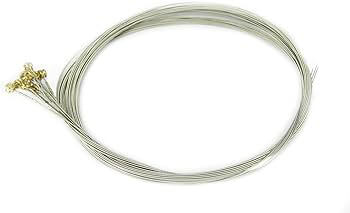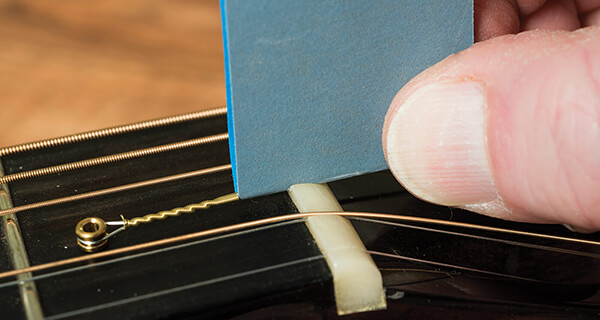Open String Buzz Electric Guitar [7 Ways to Fix]
Open string buzz on an electric guitar is a persistent challenge that can disrupt your playing experience and hinder the quality of your music. It’s a frustration that plagues both beginners & seasoned guitarists alike. Fortunately, there are proper solutions to this problem. In this guide, we will explore seven proven methods to identify, diagnose, and fix open string buzz on your electric guitar.

From basic adjustments to more advanced techniques, this comprehensive guide will equip you with the knowledge and skills necessary to conquer this vexing issue and ensure your guitar plays beautifully, free from the annoyance of string buzz. Let’s dive into the world of electric guitar maintenance and discover how to restore your instrument’s sound to its full potential.
# Table of Contents =>
- 1 Step by Step to Fix: Open String Buzz Electric Guitar –
Step by Step to Fix: Open String Buzz Electric Guitar –
I. Understanding Open String Buzz –
A. What is Open String Buzz?
Open string buzz occurs when a guitar string vibrates against a fret or a part of the guitar other than the frets when played open, resulting in an undesirable buzzing or rattling sound.
B. Why is Open String Buzz a Problem?
Open string buzz not only affects the sound quality of your guitar but can also be distracting and frustrating. It can make your playing sound unprofessional and undermine your confidence as a guitarist. Furthermore, it can indicate underlying issues with your guitar’s setup or condition.
C. The Importance of Proper Guitar Setup –
Achieving optimal playability and tone from your instrument hinges on a precise guitar setup. A meticulously set-up guitar guarantees the strings are positioned at the ideal height, the neck is perfectly aligned, and the intonation is spot-on. Neglecting a proper setup significantly increases the likelihood of experiencing open string buzz.
II. Diagnosing Open String Buzz –
A. Checking for Simple Causes –
Loose Tuning Pegs –
One of the most straightforward causes of open string buzz is loose tuning pegs. Check if the strings are securely wound around the pegs and tighten any loose ones.
Worn Strings –
Old or worn-out strings are prone to buzzing. If your strings are visibly worn or have been on the guitar for an extended period, it’s time to replace them.
Nut Problems –
The nut is a critical part of your guitar’s setup. If the nut slots are too low or too high, it can cause open string buzz. Check the nut for signs of wear or incorrect slot heights.
B. Assessing Fret Issues –
Fret Wear –
Fret wear, especially in the lower positions, can cause open string buzz. Examine your frets for grooves or divots, which may indicate the need for a fret-leveling procedure.
Fret Sprout –
Fret sprout occurs when the fret ends protrude from the edge of the fretboard. This can lead to buzzing and discomfort while playing. File or smooth out any protruding fret ends.
Uneven Frets –
Frets that are not level with each other can result in open string buzz. Use a straightedge or specialized fret rocker tool to identify uneven frets.
C. Evaluating Neck and Truss Rod –
Neck Relief –
Neck relief, the slight curvature of the neck, plays a crucial role in preventing string buzz. Use an appropriate gauge of feeler gauge to measure the neck relief and make adjustments if necessary.
Truss Rod Adjustment –

The truss rod is used to control the amount of bow in the neck. Incorrect truss rod adjustments can lead to open string buzz. Make precise adjustments to achieve the right amount of relief.
III. Essential Tools and Materials –
A. Guitar Setup Toolkit –
Building a toolkit with essential tools like screwdrivers, Allen wrenches, feeler gauges, and a capo is essential for maintaining and setting up your guitar.
B. Types of Guitar Strings –

Choosing the right type and gauge of strings for your playing style can make a significant difference in reducing open string buzz. Experiment with different string sets to find the best fit for your guitar.
C. Measuring Tools –
Measuring tools such as a ruler, straightedge, and calipers are invaluable for accurately assessing various aspects of your guitar’s setup, including action height and neck relief.
IV. Basic Setup Procedures –
A. Restringing Your Guitar –

Learn the proper technique for restringing your guitar, ensuring that the strings are securely attached to the tuning pegs and properly wound.
B. Tuning and Stretching the Strings –
After restringing, tune your guitar to the desired pitch and stretch the strings to minimize tuning instability and reduce the risk of buzz.
C. Adjusting the Action –
Adjusting the action (string height) is critical for eliminating string buzz. Follow step-by-step instructions to set the action to your preferred height.
D. Setting Intonation –
Accurate intonation ensures that your guitar plays in tune across the entire fretboard. Learn how to adjust your guitar’s intonation using the saddle adjustments.
V. Advanced Setup Techniques –
A. Dealing with Nut Issues –
Lubricating the Nut:
Properly lubricating the nut can prevent strings from binding, reducing the likelihood of open string buzz. Use graphite or specialized lubricants for this purpose.
Filing the Nut Slots:

If the nut slots are too low or too high, they can cause open string buzz. Carefully file the nut slots to the correct depth, ensuring that the strings sit at the right height.
B. Addressing Fret Problems –
Fret Leveling and Crowning:

Fret leveling and crowning are advanced procedures that can correct fret wear and unevenness, eliminating open string buzz.
Polishing Frets:
Smooth, polished frets can improve playability and reduce string buzz. Learn how to polish your frets for optimal performance.
C. Truss Rod Adjustment for Precision –
Neck Straightening:
Understand the intricacies of adjusting the truss rod to achieve a straight neck, which is essential for reducing open string buzz.
Controlling Neck Relief:
Fine-tune neck relief to achieve the ideal balance between playability and buzz prevention.
VI. Common Mistakes to Avoid –
A. Over-Tightening the Truss Rod –
Over-tightening the truss rod can lead to irreparable damage to your guitar’s neck. Follow manufacturer guidelines and make gradual adjustments.
B. Incorrect Nut Slot Height –

Setting the nut slots too low can result in buzzing, while setting them too high can make your guitar difficult to play. Ensure the nut slots are at the right height.
C. Rushing Through Setup –
Take your time when setting up your guitar. Rushing through the process can lead to oversights and result in unresolved string buzz issues.
VII. When to Seek Professional Help:
A. Complex Setup Issues –
If you encounter complex setup problems that you’re not comfortable handling, it’s wise to seek the expertise of a professional guitar technician.
B. Refretting and Major Repairs –
Tasks like refretting or addressing major structural issues are best left to skilled guitar repair experts.
C. Regular Maintenance –
Regular maintenance and minor adjustments can prevent open string buzz. Schedule periodic checkups with a professional to keep your guitar in top shape.
Conclusion –
In conclusion, open string buzz on your electric guitar can be a frustrating obstacle to your playing experience. However, armed with the knowledge and techniques outlined in this comprehensive guide, you can diagnose and resolve open string buzz issues effectively. Remember that guitar setup is a skill that improves with practice, so don’t be discouraged if it takes time to master.
In the realm of electric guitar playing, few obstacles are as irksome as open string buzz. It can turn a melodious masterpiece into a cacophonous mess and erode the joy of playing. However, with the knowledge and techniques shared in this guide, you now possess the power to overcome this challenge.
We’ve explored seven effective methods to tackle open string buzz, from the fundamental adjustments of string replacement and action settings to the more intricate tasks of nut and fret work. By applying these fixes with care and precision, you can restore your guitar’s harmonious voice.
Remember, mastering these skills may take time and practice, but the satisfaction of hearing your guitar sing free from the buzz is well worth the effort. So, embark on your journey to a buzz-free guitar, and let your music soar as it was meant to.
Last Updated on October 22, 2025 by Perry Garner


